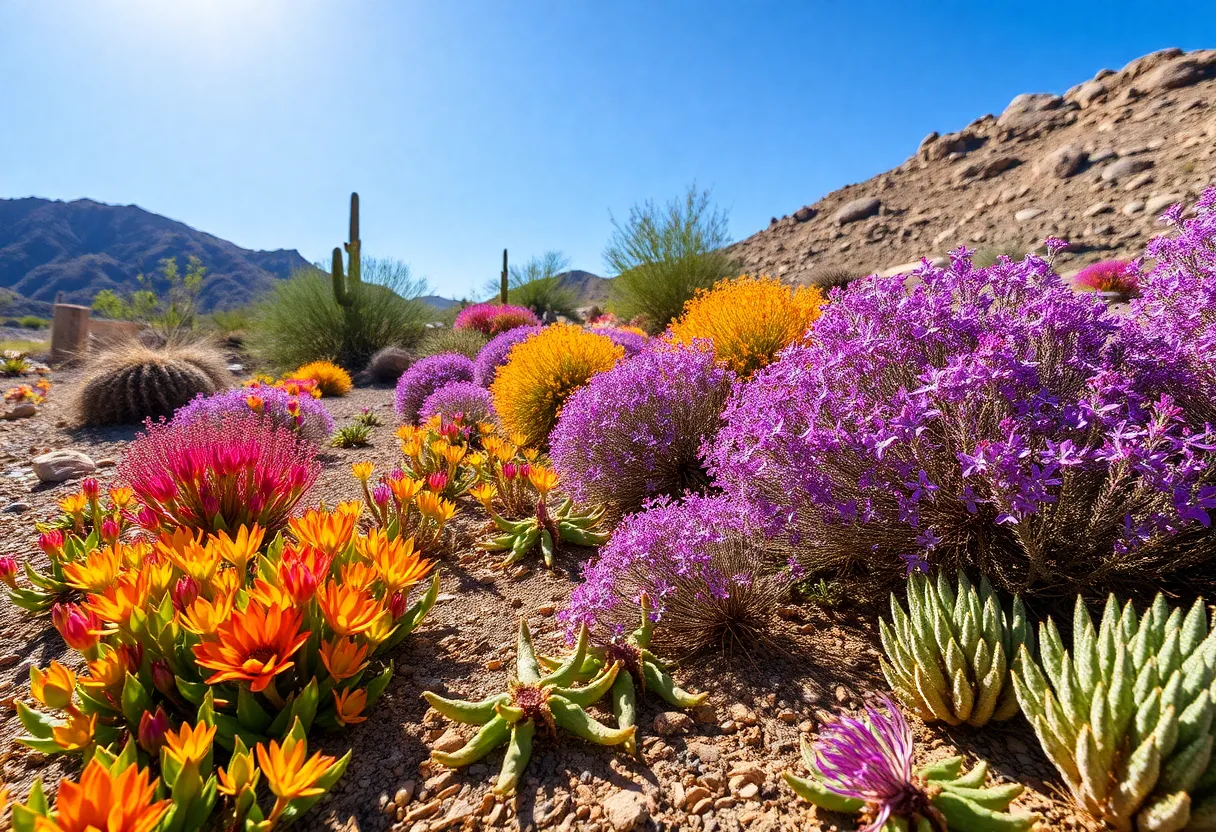Transforming Your Phoenix Landscape with the Right Ground Cover Plants
Introduction
Designing a sustainable, visually appealing landscape in Phoenix requires selecting suitable ground cover plants. The arid climate demands species that are drought-tolerant, heat-resistant, and capable of thriving in full sun. Native plants are especially advantageous—they have evolved to withstand local conditions and support local ecosystems. Proper ground cover not only enhances aesthetic appeal but also offers functional benefits such as erosion control, weed suppression, and water conservation.
Understanding the Climate and Its Impact on Plant Selection
Phoenix’s climate is characterized by high temperatures, low rainfall, and intense sunlight. These conditions challenge traditional landscaping plants, making adaption and resilience key criteria in plant selection. Native species have adapted over generations to the harsh environment, making them ideal choices for ground covers in this region. They require minimal watering and maintenance, leading to cost savings and sustainability benefits.
Top Native Ground Cover Plants for Phoenix Landscaping
1. Brittlebush (Encelia farinosa)
Brittlebush is a quintessential native perennial thriving in Phoenix’s arid conditions. Its silvery-green foliage and bright yellow flowers bring vibrancy to any landscape. Known for erosion control, it has a deep root system that stabilizes soil, particularly on slopes or hillsides. Its minimal care requirements make it an excellent choice for xeriscaping projects.
Its foliage provides interest year-round, and its flowers attract native pollinators, supporting local biodiversity.
2. Hartweg’s Sundrops (Oenothera hartwegii)
Hartweg’s Sundrops are notable for their large, bright yellow flowers. They undergo a stunning color transition, shifting to pale orange with pink hues. Ideal for areas with full sun and well-drained soil, this species enhances visual diversity and resilience in hot, dry environments.
They bloom primarily during spring and fall, attracting pollinators like bees and butterflies, which helps support local ecosystems.
3. Ice Plant (Delosperma)
Ice plants are succulents that form dense mats, featuring vibrant daisy-like flowers in shades of pink, purple, or yellow. Their fleshy leaves and high drought tolerance make them ideal for Phoenix’s climate. Variants such as ‘Jewel of Desert Garnet’ and ‘Fire Spinner’ bring a burst of color that persists through the warmer months.
Additionally, they are pollinator-friendly and require little maintenance, making them suitable for low-water gardens.
4. Creeping Juniper (Juniperus horizontalis)
Creeping Juniper is an evergreen ground cover that spreads to cover large areas. It maintains a blue-green foliage color year-round and grows low (6-12 inches high). Its dense habit effectively suppresses weeds and prevents soil erosion.
This species performs well on slopes, with deep roots aiding in moisture retention and habitat stability.
5. Lamb’s Ear (Stachys byzantina)
Lamb’s Ear features soft, velvety, silvery foliage that provides a distinct texture. It adapts well to full sun and prefers well-drained soil. Its foliage forms dense patches, helping to block weeds and contribute to visual interest in garden beds.
Its low water needs and appealing texture make it a favorite for xeriscaping and sensory gardens.
6. Dymondia (Dymondia margaretae)
Dymondia is a low-growing, drought-tolerant ground cover that creates a dense, carpet-like spread. It thrives in full sun and well-drained soils. Its deep root system aids in soil retention and erosion control, especially on slopes.
This plant is particularly suitable for pathways, edges, and areas prone to erosion, because of its resilience and durability.
7. Germander Sage (Salvia chamaedryoides)
Germander Sage is native to the Chihuahuan Desert. It produces vivid blue flowers that attract hummingbirds and pollinators. Its gray-green foliage provides a neutral backdrop, making the flowers stand out. It is hardy down to 15°F, tolerating full sun and partial shade.
8. Desert Marigold (Baileya multiradiata)
Desert Marigold offers bright yellow daisy-like flowers that bloom most of the year in appropriate conditions. It is drought-tolerant, thrives in full sun, and well-drained soils. It supports pollinators and adds cheerful color to xeriscapes, making it both an attractive and ecologically supportive choice.
9. Trailing Lantana (Lantana montevidensis)
Trailing Lantana features clusters of small, bright flowers in varying colors. It is a spreading, low-growing plant suitable for ground cover, spilling over walls or containers. Its drought tolerance, easy maintenance, and attractiveness to butterflies render it a popular choice.
10. Creeping Thyme (Thymus serpyllum)
Creeping Thyme is a fragrant herb with tiny purple or pink flowers. It forms a dense mat that can withstand foot traffic. Its full sun requirement, drought tolerance, and pollinator attraction make it a versatile addition for gaps, pathways, or between paving stones.
Implementing Ground Cover for Optimal Landscape Transformation
Choosing native ground covers promotes ecological balance and water efficiency. Proper planting techniques include preparing well-draining soil, ensuring adequate spacing, and avoiding overwatering. Regular maintenance involves minimal pruning, weed removal, and monitoring for pests or diseases.
Utilize these plants to create layered landscapes that blend beauty with functionality. Incorporate them strategically on slopes, in open beds, or along pathways to reduce irrigation needs and improve soil stabilization. Their resilient nature ensures sustainability and low maintenance over time.
Conclusion
In Phoenix’s challenging climate, selecting the right ground cover plants is vital for a vibrant, sustainable landscape. Native, drought-tolerant species not only thrive with minimal water and care but also support local wildlife and ecological health. Integrating species such as brittlebush, Ice Plant, Creeping Juniper, and others offers a comprehensive approach to transforming your yard into a resilient, visually stunning environment—a smart choice for both the environment and your wallet.
Frequently Asked Questions
What are the best ground cover plants for dry, sunny areas in Phoenix?
Native plants such as brittlebush, Ice Plant, Creeping Juniper, and Desert Marigold are ideal. They are adapted to withstand high temperatures, minimal water, and intense sunlight while providing color and ecological benefits.
How do native ground covers support local ecosystems?
Native ground covers attract local pollinators such as bees, butterflies, and hummingbirds. They provide habitat and food sources, promoting biodiversity. Their deep root systems also conserve soil and reduce erosion naturally.
Are native ground covers low-maintenance?
Yes, native species are generally low-maintenance since they are well-adapted to the local environment. They require minimal watering, fertilizing, or pest control, making them cost-effective and eco-friendly options.
Key Features of Phoenix Ground Cover Plants
| Plant Name | Primary Features | Sun Tolerance | Water Needs | Ecological Benefits |
|---|---|---|---|---|
| Brittlebush | Yellow flowers, erosion control, silvery foliage | Full sun | Low | Supports pollinators, stabilizes soil |
| Ice Plant | Vibrant daisy-like flowers, succulent leaves | Full sun | Very low | Pollinator-friendly, water-efficient |
| Creeping Juniper | Evergreen, dense coverage, blue-green foliage | Full sun, partial shade | Low | Weed suppression, soil stabilization |
| Desert Marigold | Bright yellow flowers, drought-tolerant | Full sun | Low | Pollinator support, provides color year-round |
Author: STAFF HERE PHOENIX WRITER
The PHOENIX STAFF WRITER represents the experienced team at HEREPhoenix.com, your go-to source for actionable local news and information in Phoenix, Maricopa County, and beyond. Specializing in "news you can use," we cover essential topics like product reviews for personal and business needs, local business directories, politics, real estate trends, neighborhood insights, and state news affecting the area—with deep expertise drawn from years of dedicated reporting and strong community input, including local press releases and business updates. We deliver top reporting on high-value events such as the Waste Management Phoenix Open, Cactus League Spring Training, and Arizona State Fair. Our coverage extends to key organizations like the Greater Phoenix Chamber of Commerce and Visit Phoenix, plus leading businesses in technology and healthcare that power the local economy such as Intel and Banner Health. As part of the broader HERE network, including HERETucson.com, we provide comprehensive, credible insights into Arizona's dynamic landscape.





